On March 14, the International Day of Mathematics, Professor J. Peter May from the University of Chicago was invited to speak in the 188th Science Lecture at the College of Science. He delivered a lecture titled “Finite Sets, Symmetric Groups, and Categorical Combinatorics”. In attendance were Chair Prof. Qing Xiang, the Head of the Department of Mathematics, SUSTech, and over 100 faculty members and students. It was hosted by Assistant Professor Yifei Zhu of the Department of Mathematics.

Prof. May first explained the concepts of symmetric monoidal category, permutative category, symmetric bimonoidal category, and bipermutative category through specific examples. These included sets, topological spaces, categories, and modules over a commutative ring. Based on this, he then explained in detail the black-box process of obtaining highly structured ring spectra from the above categories along with its motivations. Prof. May further introduced applications of the above constructions to areas such as stable homotopy theory and algebraic K-theory, specifically the famous Barratt–Priddy–Quillen theorem and Quillen's important work in defining higher K-groups, taking the respective additive and multiplicative structures of symmetric groups and of general linear groups as examples.
In the second part of the talk, Prof. May introduced the notions of operad and its associated algebra and monad, and elucidated by examples the ubiquity of this structure. He moved on and introduced the new concepts of multerad and bioperad, and explained their motivations from the perspectives of the above black-box process as well as the theory of equivariant multiplicative infinite loop spaces. In particular, Prof. May introduced his recent joint work with Hana Jia Kong (Zhejiang University) and Foling Zou (Academy of Mathematics and Systems Science, Chinese Academy of Sciences), and with Bertrand Guillou (University of Kentucky), including potential connection with the above new concepts, and the technical challenges in terms of categorical combinatorics.
Finally, Prof. May discussed applications of this theory to important topics such as equivariant algebra K-theory and Galois theory, with a view towards future directions. Prof. May's lecture was interspersed with intriguing anecdotes about his communications with mathematicians such as Michael Barratt, Saunders Mac Lane, and Daniel Quillen, vividly revealing the charm of mathematicians engaged in mathematical research. At the age of 85, Prof. May cast a deep impression on the audience, especially young students, with his scholarly demeanor, attitude and insight towards research, and charisma.
During the Q&A session, the audience asked questions about further intuitive examples of multerads as well as how to balance concrete calculations and abstract theories in mathematical research. Prof. May answered them thoroughly and encouragingly.

After the lecture, Prof. Xiang handed an honorary certificate to Prof. May. Per request, Prof. May signed his classic graduate textbook for students from the Fields Honors Class of Mathematics.